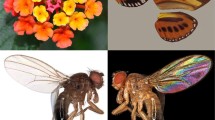Abstract.
Many insect species have darkly coloured eyes, but distinct colours or patterns are frequently featured. A number of exemplary cases of flies and butterflies are discussed to illustrate our present knowledge of the physical basis of eye colours, their functional background, and the implications for insect colour vision. The screening pigments in the pigment cells commonly determine the eye colour. The red screening pigments of fly eyes and the dorsal eye regions of dragonflies allow stray light to photochemically restore photoconverted visual pigments. A similar role is played by yellow pigment granules inside the photoreceptor cells which function as a light-controlling pupil. Most insect eyes contain black screening pigments which prevent stray light to produce background noise in the photoreceptors. The eyes of tabanid flies are marked by strong metallic colours, due to multilayers in the corneal facet lenses. The corneal multilayers in the gold-green eyes of the deer fly Chrysops relictus reduce the lens transmission in the orange-green, thus narrowing the sensitivity spectrum of photoreceptors having a green absorbing rhodopsin. The tapetum in the eyes of butterflies probably enhances the spectral sensitivity of proximal long-wavelength photoreceptors. Pigment granules lining the rhabdom fine-tune the sensitivity spectra.
Similar content being viewed by others
Author information
Authors and Affiliations
Additional information
Electronic Publication
Rights and permissions
About this article
Cite this article
Stavenga, .D. Colour in the eyes of insects. J Comp Physiol A 188, 337–348 (2002). https://doi.org/10.1007/s00359-002-0307-9
Accepted:
Issue Date:
DOI: https://doi.org/10.1007/s00359-002-0307-9




